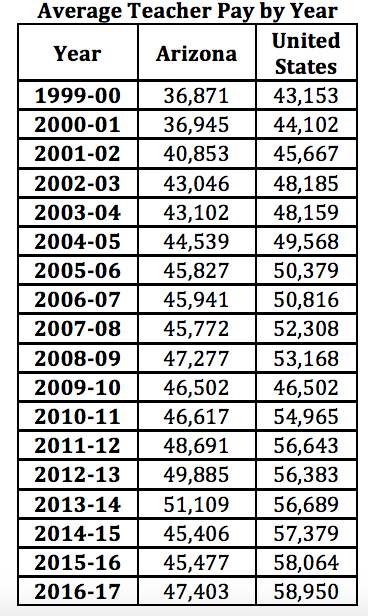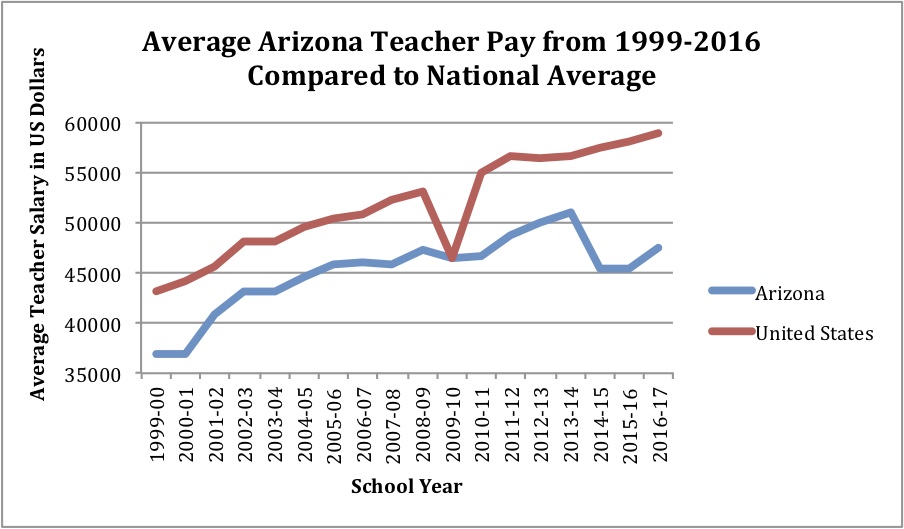As Arizona citizens ramp up the #REDforED movement, social media is blowing up with heated conversation between those who support the movement and those who don’t. I have seen a few common arguments that I will explore in this blog: (1) Teachers knew their pay when they decided to become teachers, (2) Fire the teachers and replace them, and (3) Teachers get lots of time off. I hope to shed some light on these misconceptions and promote dialogue around these topics.
Teachers knew their pay before they started
Some critics argue that teachers “knew what they were getting into” when they decided to become teachers. Every time I see this comment, it takes me back to the moment I opened my first teacher paycheck. I was standing in the kitchen of my tiny Tempe condo and I felt kind of excited—my first check as a professional! No more college jobs! I had been hired to work in an upscale part of Phoenix for $32,500/year. The drive was about 30 minutes each way, so I was actively searching for homes closer to work (where housing ran in the $200K range). With heightened emotion, I tore open the check and blinked a few times at the number—around $800.
What? Something was wrong. I was a PROFESSIONAL now. I had heard people say, “teaching doesn’t pay well,” and I wasn’t expecting an exotic lifestyle. But this seemed a little extreme. $800? Could I make it work? Seeing that first check knocked the wind out of me. I remember calling my brother in tears saying, “I can barely even afford to stay in my condo! I can’t afford to move closer to work!” At that time, the mandatory deduction for state retirement was only 2.2% and there were no costs for my insurance. Today, the mandatory state retirement deduction is 11.5% and teachers have high cost insurance premiums like other working professionals. At the end of that year, I resigned from the position to find a job where I could afford to live.
I’ve been wondering how much teacher salaries have changed from 1999 (when I decided to be a teacher) to now. Are the critics right? Should I have known what I was getting into? I decided to examine annual reports on the National Center for Teaching Statistics to see how Arizona and US teacher salaries have changed between the school years 1999-2000 and 2016-17 (their most recent report). I created the table and graph below.
These graphs were really helpful as I tried to understand what Arizona teachers are experiencing financially. See that dip on the right side of the Arizona line graph beginning in 2014-15? I remember that time in my local public school. The district held meetings to talk about the decreased school funding in Arizona, the fact that they no longer expected it to return, the disrepair of our buildings, the need for updated materials, and the increasing cost of health insurance. That year, some of those costs started getting passed to teachers. Annual raises decreased. Districts began eliminating salary schedules that increased teacher salaries based on experience and advanced education. From that point on, little has changed for teacher salaries each year. Cost of living goes up. Teacher salaries barely budge. In the graph, you can see how Arizona teacher salaries diverge from US teacher salaries in most recent years.
I started wondering about inflation. How does the current Arizona average teacher salary ($47,403) compare with the 1999 salary ($36,871) when adjusted for inflation? According to an online inflation calculator, prices in 2017 were 46.9% higher than in 1999. A salary of $36,871 in 1999 is equivalent to a salary of $54,175 in 2017. Comparing this projected teacher salary ($54,175) with the actual 2017 salary ($47,403), there’s a difference of $6,772. According to the National Center for Teaching Statistics as well as CNN, the average teacher salary has fallen 10% since 1999. Believe me, teachers can feel that difference.
As inflation rises, Arizona teacher salaries have remained very similar each year despite the gradual rise in US teacher salaries. I have heard people argue that Arizona has a lower cost of living and teachers don’t need to be paid the average US teacher salary. It’s an interesting argument that I have not fully researched (but would love to read!). However, I can say this: There is a much larger gap between teachers salaries in Arizona and the US now compared to years ago. I think that gap is the problem Arizona is facing with retaining teachers.
A note on this section: I have done my very best to create these graphs factually in good faith. Please feel free to examine the data yourself and kindly alert me if you find any errors. Links for all the data are at the bottom of the blog.
Fire the teachers and replace them
For those who have not followed recent news about the teacher shortage in Arizona, this might seem like a solution. But the truth is: Arizona is already hemorrhaging teachers! In December, AZ Central reported there were 2,000 open Arizona teacher positions and 3,400 jobs filled by people who were “not trained to teach.” There simply aren’t enough people—trained or untrained—willing to work in schools given the Arizona teacher working conditions right now.
In May 2017, our state legislature reduced the requirements for teacher certification claiming there are people who would teach if certification were easier. It has not brought a flood of teachers. In September 2017, Governor Ducey launched Arizona Teachers Academy, offering scholarships to individuals who desire to teach. Teacher flood? Nope. If you know any real-life teachers, you have heard that teaching is a very demanding job. And the truth is: There aren’t enough people willing to be teachers in Arizona right now.
I have written about how the teacher shortage has affected me—how it’s REAL and very troubling—and how we cannot even get substitute teachers. Daniela Robles wrote an excellent piece about how the teacher shortage affects students, especially when unqualified individuals are hired to fill positions. We need to retain every Arizona citizen who is willing to teach. And we need a plan to improve funding and working conditions in AZ schools to make that possible.
Teachers get lots of time off
When people think about how much time their kids get off school, they think that teachers get lots of time off school. I think this misconception makes a lot of sense from that perspective. What are those teachers doing while your kids are at home? Honestly, they are probably working!
Yesterday, I saw a Tweet mentioning that teacher contracts include 210 paid days. The author argued that teachers only work 2/3 of the year, so $40K is not a bad salary. Put that way, it’s a really good argument. Here’s the truth though: Teachers only get PAID to work 210 days a year. But teachers work far more than 210 days per year. Have you talked to teachers who work 60 hours a week? On their weekends? Over holiday breaks? During the summer? I can tell you: I am one of those teachers and I know many, many more.
Because of the large class sizes in Arizona (some of the highest in the nation), Arizona teachers work far outside school hours and contracted days. If you’ve ever seen a beautiful, well-organized classroom at Back-to-School Night, you have seen how teachers spend their summers. See, teacher contracts only start a few days before students return—and those days are packed with meetings and trainings. Many teachers return to work early (unpaid) or work very late nights to get their classrooms nice and shiny before students arrive. Arguing that teachers are paid well for their “210 days” just adds insult to injury. Teaching is not a standard 40 hour, 5 days a week job in Arizona. There is far too much work to do. Balancing work-life and personal life is a major struggle for Arizona teachers, and it makes the job very stressful. We could fix this problem by increasing pay or decreasing the class size so the workload and pay are more balanced compared to other jobs.
The bottom line here is that, regardless of how many days teachers are officially paid to work and whether that wage is fair, we need teachers who are willing to work in the state of Arizona! Whatever we choose to pay teachers has to be a livable wage that makes individuals willing to complete teacher training and show up each day for work. What we are finding in the state of Arizona is that there are no longer enough individuals willing to do that.
Some people say that teachers walking out on Thursday are “walking out on kids.” I disagree. The teachers who walk out on kids are the MANY who abandon this job year after year after year. The teachers who are walking out on Thursday—whether or not you agree with them—are teachers hoping to create better working conditions so they can STAY!
Thank you for taking the time to read about these three common teacher misconceptions. I look forward to your comments down below. For those wishing to better understand the #REDforED movement that seeks to improve education in Arizona, you might enjoy my recent blog. Please do get involved advocating for education in Arizona. Kids, teachers, and schools need you!
Links to data from the National Center for Education Statistics (used to create table and graph): 1999-00, 2000-01, 2001-02, 2002-03, 2003-04, 2004-05, 2005-06, 2006-07, 2007-08, 2008-09, 2009-10, 2010-11, 2011-12, 2012-13, 2013-14, 2014-15, 2015-16, 2016-17
Feature image credit: https://pxhere.com/en/photo/1136501












Comments 9
Great article! Thank you! The only thing I would take exception with is that all those who leave the profession are “walking out” on kids. I had to take a year off and have not decided whether or not to return, because I could not be the best for my students, given the stress, poor funding, and absolute exhaustion. I worked tirelessly for years in my attempts to tackle the issues that are now, finally, being addressed. I ended up sick because of it. Good teaching takes everything you’ve got. It’s not always cut-and-dried. Abandoning was not how I would define the very difficult choice I made. That being said, I fully stand behind the efforts of Arizona’s Red for Ed movement and the walk-out. It is necessary & overdue.
I’m so glad you wrote this comment, Lucy. I had not thought about how that comment could be hurtful to those who have made the difficult choice to leave temporarily or permanently (for whatever reason). I actually took three years off myself after my first (very stressful!) year teaching. I always planned to go back once I was “recharged” and eventually, I did! I hope circumstances improve so that you are able to return if you desire to do so!
This is a great comment that a person posted in Facebook after reading the blog. I wanted to share it here. I especially appreciated the first point!
1: I knew it was “low paying”, but signing a contract without knowing what the legislature would fund and therefore what the district would pay brought me to a situation where each contact, already signed, surprised me with an even lower salary than the year before.
How many other professional industries get employees to sign contracts without telling them the actual salary?
2: who will they get to replace teachers?….there is already a shortage.
3: time off without pay.
How many people would happily take an unpaid vacation for the summer? Bills still need to be paid. This is why teachers take in 2nd, 3rd or even 4th jobs all while still prepping for their 1st job.
This individual makes a great point. Every year, teachers have to sign their contracts in March. Contracts are prepared based on a teacher’s salary the previous year. We are told that the school board will adjust the salary with a raise if possible once the state legislature passes the budget for the next school year. Even if a teacher decided to leave after the final numbers come in, most contracts carry a penalty (often around $2500) to break a signed teacher contract.
I saw some really interesting information on a CBS news segment that I wanted to include here. I’ve heard people argue that cost of living is low in Arizona, so teachers shouldn’t need to be paid as high as the national average salary for teachers. I’ve never had the data to agree or disagree with that point. But yesterday, I saw the AZ teacher salary adjusted for cost of living and it’s actually EVEN LOWER! $42,474 compared to the $47K often used as the average AZ teacher salary in the news. I thought that was such an interesting detail. Compared to the average teacher salary when adjusted for cost of living, Arizona teachers make (on average) $13,326 LESS than the national average for teacher pay.
https://uploads.disquscdn.com/images/6327f72a73b694cc2e1fefc701199fb38b2a6bc03a3df0c62b406d1410833107.png
Additionally, CBS showed how the national average for teacher pay has fallen by $1560 over the last 10 years when adjusted for inflation. In that same 10 year time period, the average salary for college graduates in the US has increased by $6448 when adjusted for inflation. These numbers made it very clear why teachers around the nation are feeling poorer–and why their jobs may seem financially undesirable when compared to the jobs of their non-teacher friends. https://uploads.disquscdn.com/images/21f6edec6432ca5ff853da15f9fbca6a38b35762e95361bad703505d13b1a69d.png https://uploads.disquscdn.com/images/10ada863de6506c4e9ed85c895782258bfeb98ce704db7fc0f9348fc735fca08.png
To add to problem 1: In my area, a HUGE part of the salary problem is that housing has skyrocketed in recent years- it is very, very difficult to find anything under $400K that could fit a family, and that $400K house won’t be particularly nice. Housing prices have outpaced inflation considerably in many areas of the country- I’d assume any large metropolitan area (particularly on the coasts) has this problem.
This is why, when I hear bitter attacks on six-figure teachers, it’s always someone in a place where cost-of-living is completely out of control. If you want your teachers to live within commuting distance of the school, you have to pay them so they can live there!
On top of that, the whole “You knew what you were signing up for!” problem is so inaccurate as far as teacher responsibilities goes. The job is very, very different from how it was even a decade ago, as far as paperwork requirements and state test pressure.
Such great points! Thanks so much for sharing your thoughts!
In AZ, there may be a lower cost of living. However, I believe that is because (in part) AZ doesn’t appropriately fund its schools and does not appropriately pay its teachers. The result is schools which perform worse when compared to states with higher costs of living and that (not surprisingly) fund their schools and pay their teachers. You get what you pay for. It’s time for Arizona to start valuing education by funding it! Yes, cost of living may increase…but, so will quality of life if our education system produces better outcomes. AZ could then become more competitive when it comes to attracting businesses and professionals to our state.
Thank you for your comment Frankie! I absolutely think we need to increase funding to schools. I am so proud of educators for standing up for our students and what they deserve! I was so surprised by the slides (above) to see that cost of living isn’t as low as I thought it might be. When the 47k typically reported as avg AZ teacher salary was adjusted for cost of living, it went down to 42k (meaning teachers have less purchasing power here than they would in other parts of the country.) I’m curious where exactly AZ falls in cost of living. I’m guessing we might be around the middle compared to the rest of the country. I will try to find more info and post it if I can find it. Thanks so much for joining the discussion!!!